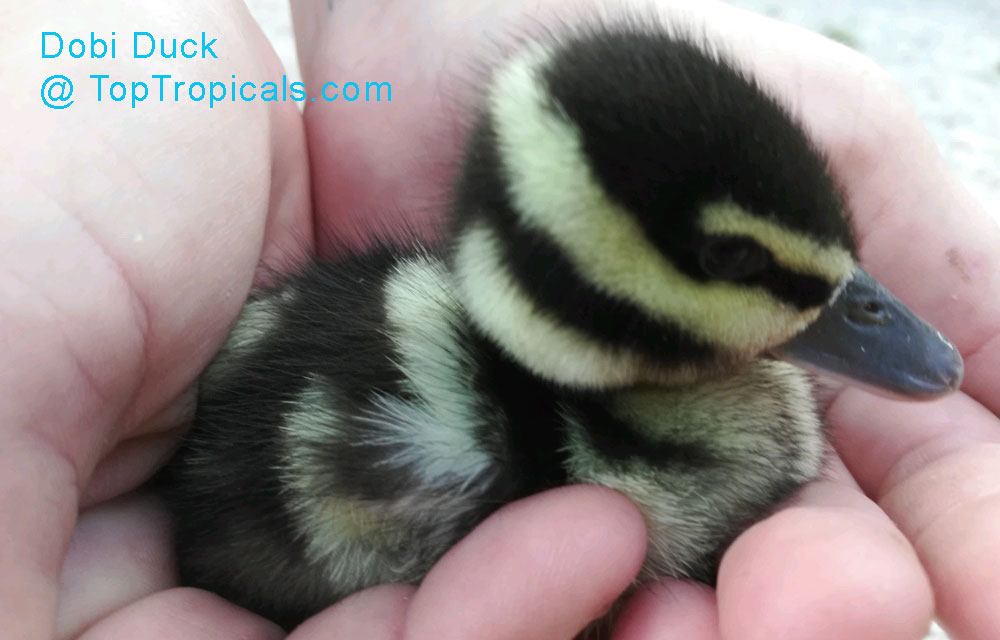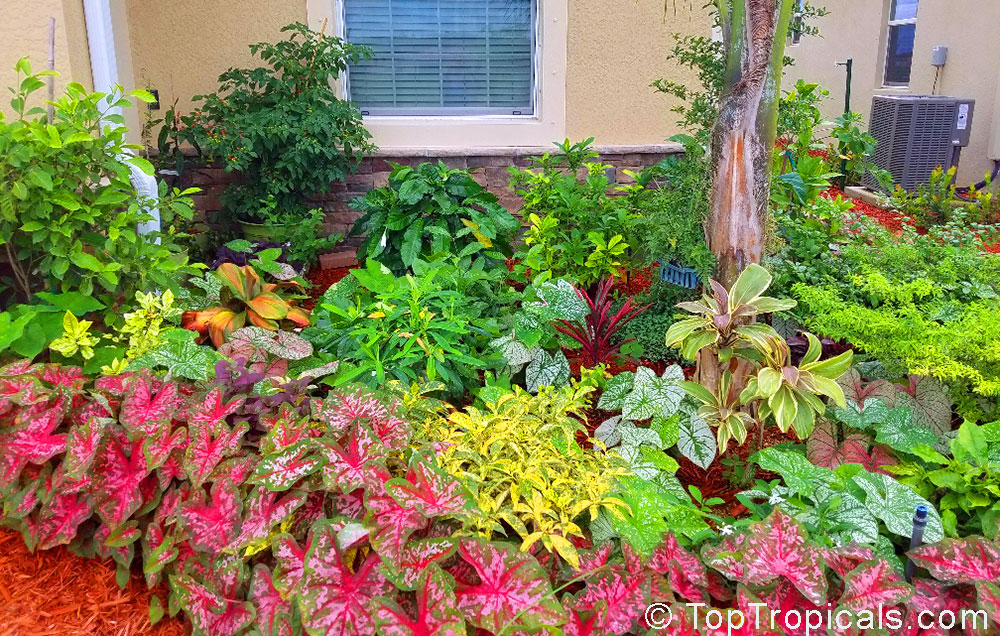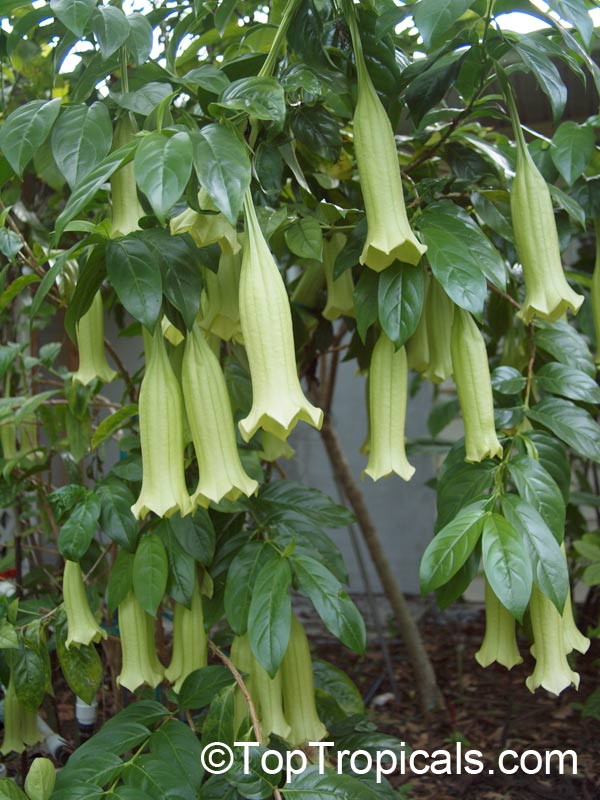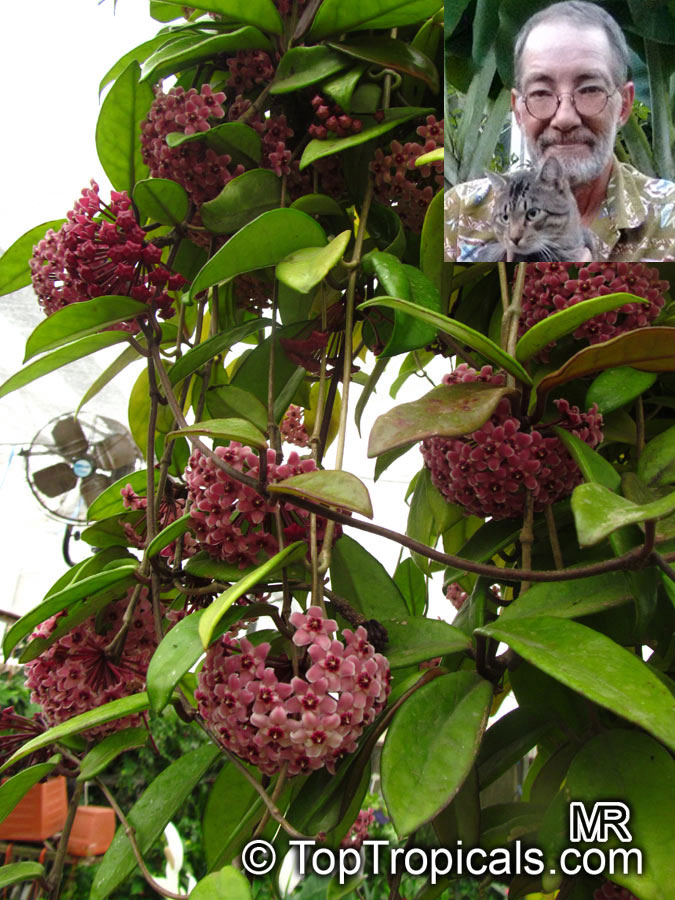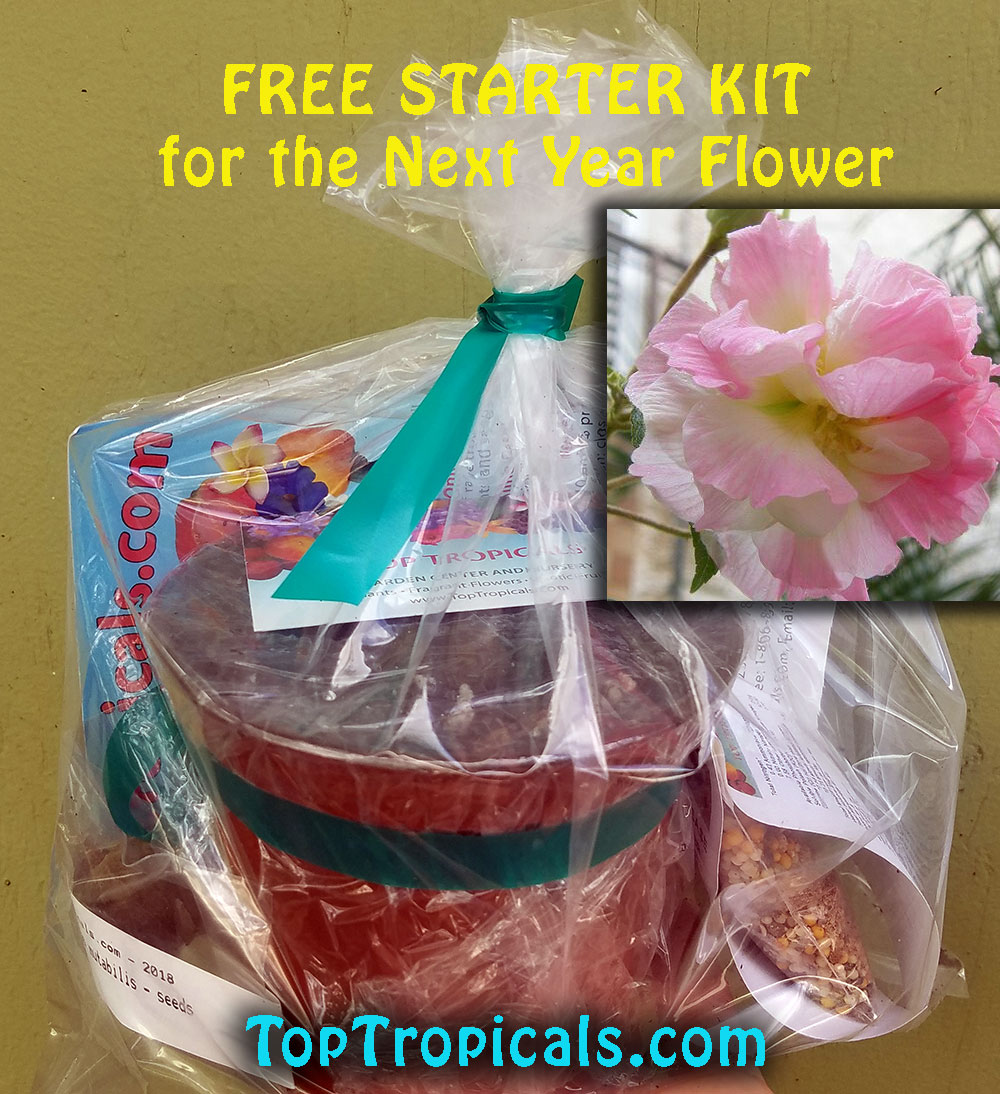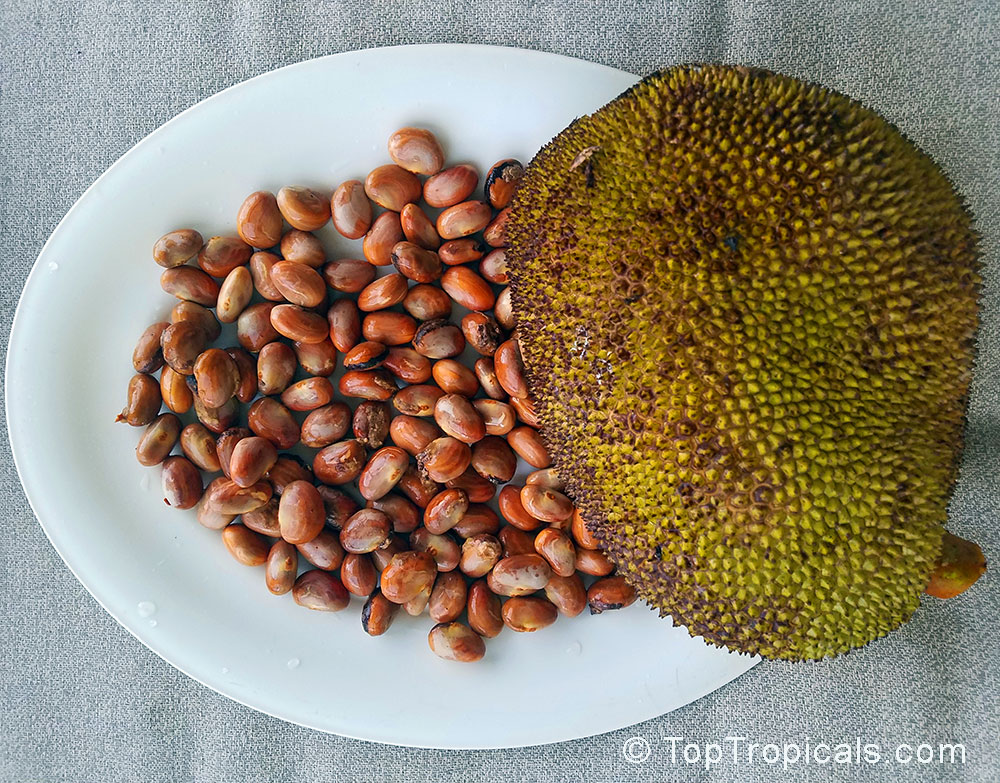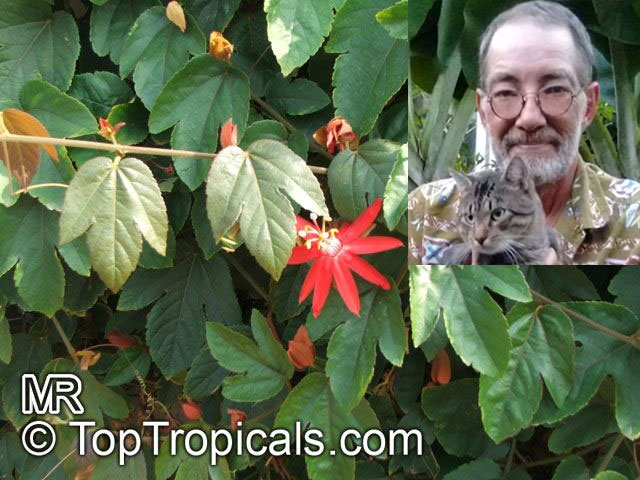Garden Blog - Top Tropicals
Date:
Butterfly Garden from Anna Banana
Butterfly facts
1. There are approximately 20,000 different species of
butterflies, the largest of which is the Queen Alexandra
Birdwing with a wingspan of 11 inches.
2. Female butterflies can lay over 1000 eggs during their
short lifetime.
3. Butterflies lay their eggs on host plants which usually
hatch within a few days, then turning into caterpillars.
The caterpillar will then eat until it sheds it's skin
several times, called instars, finally emerging from the
chrysalis as a beautiful butterfly.
4. Butterflies are born to breed, their goal being to mate
and begin the cycle again. Most live only a few days
except the Monarch which can live up to six months.
5. Monarch butterflies migrate to Mexico every fall and
remain there until spring when they make the return
migration.
6. Due to the continuing destruction of the rain forests,
where the largest population of butterflies are found,
their numbers are dwindling. We encourage you to plant a
butterfly garden!!
Remember:
- A sunny, less windy location is best, however, Zebras
love to float in the shade of bushes and trees.
- The more host and nectar plants you have, the more
butterflies will be attracted to your garden.
- Butterflies "puddle". They like a wet sandy area where
they congregate and sip minerals and nutrients from the
wet sand and water.
- Rocks to rest and enjoy their beautiful garden, and
don't forget a bench or hammock for yourself.
FREE butterfly garden guide from Anna Banana
For our local Florida customers, it is a perfect time now
to start a garden with plants for butterflies that will
appear first thing in Spring. Establish these plants now
for the Spring blooms that will attract the Beauty into
your garden!
Stop by our Garden Center to check out our Butterfly Plants display, or
simply call Anna Banana for a free consultation on
Butterfly Garden at 239-771-8081.
Hurry up while butterfly plants are on 4-day sale!
Date:
Dobi Duck @ Top Tropicals
Introducing a new member of Top Tropicals Team: Duck Dobi. Full name is Adobe (Acrobat or Photoshop - he is both active and colorful perrrson).
A customer brought us this little guy who was lost on
the street, probably left behind when his Mama took her
babies across the road. (Why did the Duck have to cross
the road after all?)
So Kristi adopted Dobi. He has been doing great for the
last couple of days, decided that Kristi is his Mom so
he is following her everywhere. TopTropicals cats are
excited but staying away knowing better: don't mess with
Mama Kristi!
Those of you who know little secrets how to raise little
ducklings please drop us a line! Dobi is our
first experience in raising something different than
plants or cats!
Date:
October Tropical Garden: to do list
1. Prune. Last pruning before winter. Check the trees and shrubs one more time. Cut away dead wood and remove crossing limbs and branches.
2. Mulch. Continue to mulch to stop weeds and get ready for winter. Keep mulch 1-2 inches away from the stems. Evenings are starting to cool, so it is more comfortable working in the garden.
3. Pest control. Check for mealy bugs and scales. Remember that a garden with many kinds of plants has fewer pests than gardens with lots of mass plantings. So keep up with variety! Avoid pest magnets like Oleander, Oak, Hibiscus which require constant spraying.
4. Propagation. You still can take cuttings but do it as soon as possible. Days are getting shorter and less sunlight signals thу plants to slow down their growth. Cuttings will not root as quickly.
5. Seeds. Consider growing vegetables and perennials from seeds. In mild cooler conditions, seedlings have less stress and get a good start.
Date:
Top Tropicals Powerpoint
Presentation by Anna Banana:
"Let's grow something different!"
Mark your calendar: Anna Banana's Presentation "Let's grow something different" Oct 16 @ 2 pm.
Learn more about rare tropicals and how to grow them in non-tropical climate. Cold protection, water-wise, soil improvement and much more.
Where: ALVA Garden Club
Meeting Location: The Alva Library Museum, 21420
Pearl Street, Alva, FL 33920
When: Tuesday, October 16th @ 2 pm.
Contact Phone Number for the Event: 239-728-3386
See more info about this event.
Date:
Portlandia - rich hot chocolate with vanilla
From Mark, the Garden Whiz. Since working in the horticultural field for nearly 50 years, at either nurseries or botanical gardens both in Florida and southern California, I have come into contact with a LOT of very cool plants. So many of them in-fact, that it's becoming increasingly difficult to run across new ones that really make me take special notice. Since being at Top Tropicals for a while now, there are a few species I had not met before which really stand out. Among them are a couple of kinds of Portlandia. Continue reading...
Date:
Lovely Jasmine Belle of India makes you feel pretty and loved!
This one is the most wanted variety with
elongated petals that are sweetly scented. Compact and
slow growing shrub, it makes a great houseplant and
flowers freely throughout the year. The most profuse
flowering is from Spring to Summer.
Called pikake in Hawaii, Jasmine sambac is the plant
used to flavor the jasmine tea and making perfumes.
Perfect houseplant takes both sun or shade, it is a
beautiful fragrant everbloomer for your home and garden.
Belle of India is a slow grower, with pale green pointed
leaves and double flowers with elongated narrow petals.
Prefers filtered light for a better look of the leaves,
but will tolerate full sun. In fact the more sun the
more flowers you get.
Secrets of successful culture:
1) use only well-drained potting soil
2) keep the plant a little bit on a dry side so roots
don't get too wet. Water again when the soil gets
slightly dry.
3) Use micro-element mix - SUNSHINE Superfood works
the best. It will keep leaves nice and green and induce
more profuse flowering.
Stay updated with TopTropicals Videos by subscribing to our channel at YouTube.com/TopTropicals and get our latest video news of what is fruiting and blooming!
Date:
Multi-flowering Hoyas:
from Mark, the Garden Whiz
Q: A few months ago, i was given a Hoya vine. At the time, I was told to not cut-off the flowers but was never told why. However now that it IS flowering, they are so wonderful I would like to. Is there really a reason to not clip them off?
A: Actually, that was very good advise. Unlike most plants we encounter, hoyas develop perennial flower spikes. This means that each spike flowers more than just once! In other words, after the flowers on such a spike have gotten old and fall off, the knobby ended spike remains. Then, after a period of time, that same spike will develop another ring of flower buds. Depending on what kind of hoya it is, these perennial flower spikes may continue to periodically make more flowers for several years! And while the plant will continue to make more of these perennial spikes its whole life, the flowering display becomes better all the time as more and more spikes grow. (By the way, these are technically called "flowering spurs"). So every time a spur might be cut for ornamental purposes, it'll be one less place the vine can flower from in future years.
Date:
FREE STARTER KIT
FREE STARTER KIT with a FREE Happy Mile Card
Sign up for Happy Miles Card and/or attend Harvest Fest and get
a FREE STARTER KIT for the Next Year Flower that
includes:
-
Sunshine S
-
fertilizer
- Literature on Sunshine, seed germination, fertilizer
and Soil
- A pot with professional seed growing mix
- Seeds of Cotton Candy Hibiscus - a
seed pod with lots of seeds inside.
Sign up for FREE Happy Miles card and get the kit RIGHT
NOW! Hurry up while supply lasts!
Date:
Information on new exotic fruit
variety:
Artocarpus x integer (Jackfruit x Chempedak), Cheena cv.
TopTropicals
FRESH SEEDS! Grow exotic Chempedak from seeds and you will have the trees for only $1 each!
Check out a short video of the opened fruit.
Cheena is a natural hybrid between jackfruit and
chempedak. Comes true from seed.
This highly recommended variety has grown in TopTropicals
garden from a seedling of Cheena (Jackfruit x Chempedak)
that fruited within 3 years from planting. The fruit
(20-25" size) is probably the best we ever tasted! It is
super sweet, crunchy and has a rich, pleasant, excellent
flavor. It has very little latex which makes it easy to
handle when cutting up. The tree produces at the very base
of the trunk, so you can prune it as short as you want.
Our tree survived light frosts as well as 48 hours of 3ft
flooding, with no damage!
The tree has an open, low and spreading growth habit and
can be maintained at a height and spread of 8 ft with
annual pruning. It is very easy to grow and is not as cold
hardy as we thought for a Jackfruit x Chempedak types of
plants. The only two recommendations are - good fertilу
soil with a high content of compost and regular watering.
Cheena is a consistent producer. The fruit is up to 5 lbs,
long, narrow and uniform in size and shape. The skin is
green, with blunt spines that yellow and open slightly
upon maturity.
Check out Chempedak Cheena seeds - FRESH - FRESH -
FRESH
Check out Chempedak Cheena plants - special
offer $30 OFF!
Date:
How to get Passion Vine to flower?
From Mark Hooten, the Garden Whiz
Q: Several months ago, I purchased a passionflower vine, a red one with lots of flowers. I ended up putting it in a much larger pot with a large trellis, using a popularly advertised bagged potting soil recommended at a big box store. I have given it a blue colored water-soluble fertilizer every couple of weeks as recommended. However, while the vine seems very happy, growing faster than i can keep winding it around the trellis, it has not flowered all summer. I there something I am doing wrong?
A:
Passionvines as a group (and there are some 500 different kinds!) are sort-of
unusual among popularly grown ornamentals because they have "nitrogen issues". This
is because, even though unrelated, they are much like most legumes, as they
maintain a symbiotic relationship with certain beneficial soil bacteria which
allows them to gather atmospheric nitrogen and store it in their roots. When
they have an overabundance of nitrogen, they simply stop flowering and
produce rampant leafy growth while never flowering. They only flower well after a
period of healthy vine growth, because the plant had finally used up all of
its stored nitrogen.
Since you had both used a bagged potting soil which likely already
contained fertilizer with nitrogen added, as well as bi-monthly doses of a liquid
fertilizer which also contains nitrogen, it has been receiving so much
nitrogen it only knows to grow more vineage until the nitrogen is used up. If and
when that happens, it will again begin to flower. This rule applies of course
not only to flowering but also to fruiting varieties of Passiflora: the more
flowers, the more fruit you get!
So the answer is - for the time being, just stop giving it supplemental
fertilizer and it will start flowering for you sooner than later!
See all passion vines from TopTropicals.



